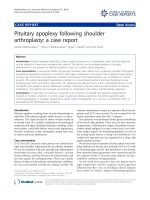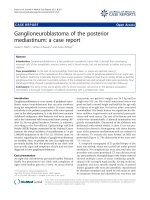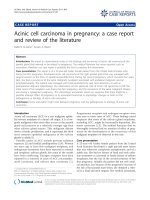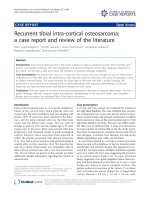Báo cáo y học: "Fatal cold agglutinin-induced haemolytic anaemia: a case report" ppt
Bạn đang xem bản rút gọn của tài liệu. Xem và tải ngay bản đầy đủ của tài liệu tại đây (217.62 KB, 2 trang )
CAS E RE P O R T Open Access
Fatal cold agglutinin-induced haemolytic
anaemia: a case report
Gianluca Lodi
*
, Daniela Resca, Roberto Reverberi
Abstract
Introduction: Cold agglutinin disease usually develops as a result of the production of a specific immunog lobulin
M auto-antibody directed against the I/i and H antigens, precursors of the ABH and Lewis blood group substances,
on red blood cells. Autoimmune and lymphoproliferative disorders, Mycoplasma pneumoniae and other infections
can be associated with the production of cold agglutinins. In its classic presentation with haemolytic anaemia and
Raynaud’s syndrome, cold ag glutinin disease is usually idiopathic. Several factors play a role in determining the
ability of a cold agglutinin to induce a haemolytic anaemia such as antibody concentration and temperature
range, in particular the highest temperature at which antibodies interact with red blood cells.
Case presentation: A 48-year-old Caucasian man presented to our hospital with symptoms of extreme asthenia
caused by severe anaemia. The transfusion of red blood cells (O Rh-positive), started as prescribed by the
emergency guidelines in force without pre-transfusion tests, induced fatal haemolysis because of the presence of
high levels of anti-H antibodies in his blood, that reacted with the large amount of H antigen in universal (0) red
blood cells.
Conclusion: Emergency transfusion of universal red blood cells (0 Rh-positive or negative) is usually accepted by
the international guidelines in force in emergency departments. In this report we describe a rare complication
caused by the very high concentration in the recipient of cold agglutinins and the activation of the complem ent
system, responsible for red blood cell lysis and consequent fatal cardiovascular shock. We conclude that
emergency transfusion of universal red blood cells (0 Rh-positive or negative) may be dangerous and its risk
should be assessed against the risk of delaying transfusion until the pre-transfusion tests are completed.
Introduction
Cold agglutinins were first described by Landsteiner in
1903 [1]. Their pathological action against red blood
cells (haemolytic anaemia) and blood vessels (Raynaud’s
syndrome) was described some years later by Clough
and Iwai [2,3]. In 1953 Schubothe coined the term: Cold
Agglutinin Disease (CAD) [4].
CAD is characterized by an auto-antibody [5] which is
able to agglutinate red blood cells (RBCs) at tempera-
tures lower than that of the body, and subsequently to
activate the complement system responsible for lysis of
RBCs.
Patients show haemolytic anaemia of varying degrees
of severity, as well as episodes of hemoglobinuria and
acrocyanosis, which arise or worsen upon exposure to
low temperatures.
Cold agglut inin antibodies are mainly specific for the
I/i and H RBCs membrane systems [6], and their pro-
duction can be stimulated by Mycoplasma pneumoniae
or infection by the Epstein-Barr virus, as well as by lym-
phoproliferative disorders such as Waldenström’ s
macroglobulinemia.
The auto-antibody involved is usually an IgM, less fre-
quently an IgA or IgG, which is able to agglutinate
RBCs at temperatures of between 0 and 5°C. Comple-
ment activation generally occurs between 20 and 25°C,
but is also possible at normal body temperature. It is
also important to note that agglutination is not neces-
sary for compl ement activation, especially in patients
with high levels of auto-antibodies (wide thermal range
of cold agglutinins) [7,8]. This obviously has serious
repercussions in a clinical setting.
* Correspondence:
Blood Transfusion Service - Arcispedale S. Anna, 203 C.so Giovecca, 44100
Ferrara - Italy
Full list of author information is available at the end of the article
Lodi et al. Journal of Medical Case Reports 2010, 4:252
/>JOURNAL OF MEDICAL
CASE REPORTS
© 2010 Lodi et al; licensee BioMed Central Ltd. This is an Open Access article distributed under the terms of the Creative Commons
Attribution License ( which permits unrestr icted use, distribution, and reproduction in
any medium, provided the original work is properly ci ted.
Case presentation
A 48-year-old Caucasian man presented to the Acci dent
and Eme rge ncy Department of our hospit al with symp-
toms of extreme a sthenia, but showed no evidence of
Raynaud’s syndrome. In the past few months, he had
complained about a productive cough and post-prandial
vomiting. At admission, he was evidently dehydrated
and undernourished, very pale, dyspnoeic and tachycar-
diac (110 bpm) at rest. Heart sounds were soft but no
other pathologic sign concerning his lungs and abdomen
was noted. His blood pressure was 80 over 50 mmHg.
A blood cell count showed severe anaemia (haemoglo-
bin = 3.8gr/dl) and the patient was prescribed an emer-
gen cy transfusion of RBCs (0 Rh-positive), owing to the
severe anaemia associated with dyspnoea and tac hycar-
dia at rest, and hypotension. Blood samples were also
sent to our Blood Transfusion Service at this time. Pre-
vious data relating to our patient was not found in our
records.
After centrifugation, samples showed low hematocrit
and normal plasma appearance. The direct blood group
test resulted in unequivocally A with Rh phenotype
Ccddee, while the indirect test revealed agglutination of
B cells and a strong agglutination of 0 cells. Antibody
screening also showed strong agglutination (4+) of all
panel cells.
The above-mentioned Accident and Emergency
Department was immediately alerted to our p atient’ s
immuno haematological situation, and we advised urgent
cessation of the transfusion of RBCs (0 Rh-positive),
which t he physician had already initiated as prescribed
by the emergency guidelines in force. We also recom-
mended our patient’s transferral to the Haematology
Department in Ferrara City Hospital, where he arrived
in a state of severe cardiovascular shock.
Blood samples taken f rom him at this time showed
dramatic haemolysis, which led to his death within a
few hours.
Subsequent blood tests revealed the presence of cold
agglutinin syndrome with very high levels of anti-H
(1:65.600). He showed positive (3+) results for the direct
antiglobulin test for complement fractions, which caused
the intravascular haemolysis and consequent cardiovas-
cular shock.
His death prevented furthe r attempts to define the
aetiology of his condition. However, an emergency ultra-
sonography had shown several enlarged lymph nodes
(average diameter, 5 cm) along the iliac vessels and the
thoracic and abdominal aorta, suggesting a lymphoma-
tous pathology.
Conclusion
The dramatic clinical situation of our patient upon pre-
sentation led the physician to commence emergency
transfusion of universal RBCs (0 Rh-positive) according
to the guidelines which were designed to safeguard
against major complications such as multi-organ failure
due to severe anaemia.
However, the transfusion of 0 RBCs, expressing a large
amount of H antigens, caused dramatic haemolysis, car-
diovascular shock and our patient’ s death within a few
hours.
We conc lude that emergency transfusion of universal
red blood cells (0 Rh-positive/negative) may be danger-
ous and the risks of the procedure should be assessed
against the risks of delaying transfusion until the pre-
transfusion tests are completed.
Consent
Written consent was obtained from our patient’snext-
of-kin for publication o f this case study. A copy of the
written consent is available for review by the Edito r-in-
Chief of this journal.
Acknowledgements
The authors greatly appreciate the technical assistance of Ms. Paola
Bonauguro and Mr. Alberto Castellani.
Authors’ contributions
GL and DR performed pre-transfusion evaluations and made the diagnosis;
then they searched the literature for other similar reports. GL and RR drafted
the manuscript. All authors read and approved the final manuscript.
Competing interests
The authors declare that they have no competing interests.
Received: 21 October 2009 Accepted: 6 August 2010
Published: 6 August 2010
References
1. Landsteiner K: Über beziehungen zwischen dem blutserum und den
korperzeller. Munch Med Worchenschr 1903, 50:1812.
2. Clough MC, Richter IM: A study of an autoagglutinin occuring in a
human serum. Johns Hopkins Hosp Bull 1918, 29:86.
3. Iwai S, Mei-Sai N: Etiology of Raynaud’s disease. Jpn Med World 1926,
6:345.
4. Schubothe H: The cold hemagglutinin disease. Semin Hematol 1966, 3:27.
5. Petz LD, Garraty G: Acquired Immune Hemolytic Anemias New York: Churchill
Livingstone 1980, 63-76.
6. Geoff D: Human Blood Groups London: Blackwell Science Ltd 1995, 53-61.
7. Mollison PL: Blood Transfusion in Clinical Medicine. 11th Ed London: Blackwell
Scientific Publications 2005, 286-295.
8. Sharon GG: Cold agglutinin disease. Medscape Journal, eMedicine from
WebMD 2008.
doi:10.1186/1752-1947-4-252
Cite this article as: Lodi et al.: Fatal cold agglutinin-induced haemolytic
anaemia: a case report. Journal of Medical Case Reports 2010 4:252.
Lodi et al. Journal of Medical Case Reports 2010, 4:252
/>Page 2 of 2









